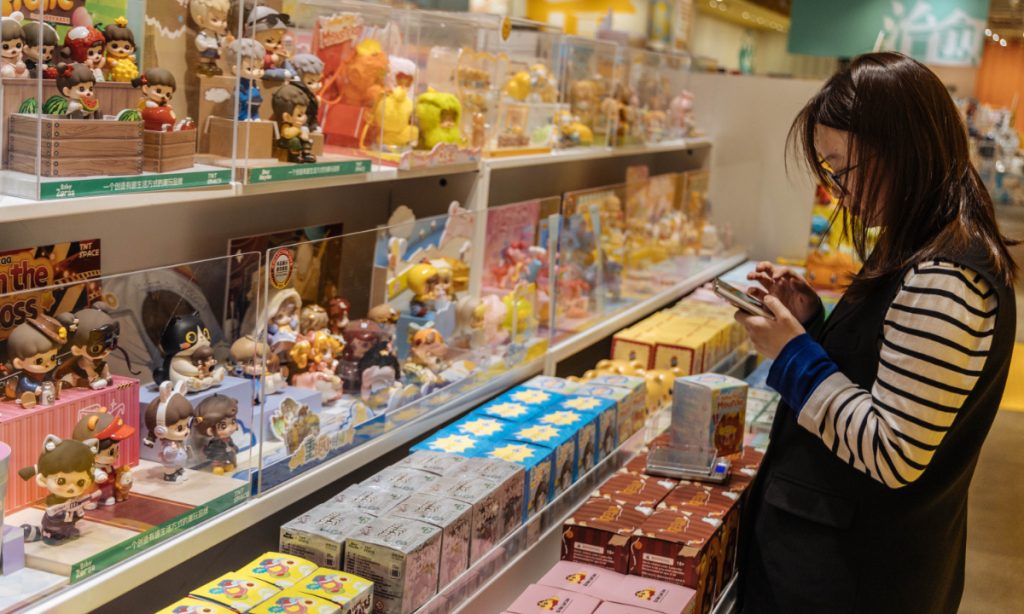Emotional spending reshapes youth consumption in China, injects new vitality into traditional malls

Cradling the blind box in her hand, Yang Hailun gave it a gentle shake, hoping the faint clatter inside might offer a clue to the surprise sealed within.
Eventually, she picked this one and headed to the store’s counter to pay.
When she unveils a Minnie Mouse figurine – her top pick – she’s all smiles, ready to hunt for more.
Yang, a Beijing resident born in the 1990s, often meets her friends at various shopping malls after work or on weekends.
Besides dining out, she and her companions are avid visitors of stores that sell blind boxes, anime figurines, and collectible cards. These types of shops are becoming increasingly popular in Chinese malls.
“Whether it’s for my favorite cartoon characters or a pretty design, I’ll pay for it,” Yang told the Global Times. “I display them at home or in the office as decorations. Seeing them makes me happy.”
Today in China, for many consumers like Yang, spending money for the sake of such “happiness” has become routine. Trendy blind boxes and anime figurines now decorate office desks, bringing joy to young people.
This type of consumption – driven by psychological experience and the need to satisfy emotional desires – is known as emotional consumption. According to a latest study released by the China Consumers Association (CCA), emotional release is becoming a major factor influencing the purchasing decisions of the younger generation, the Xinhua News Agency reported in March.
Data from multiple research institutions shows that China has nearly 500 million users who engage with ACG (animation, comics, and games) content. The “ACG-style” consumption market exceeds 100 billion yuan ($13.8 billion) in size, Economic Information Daily reported in July 2024.
Young people are the most dynamic driving force in the market as the core consumer base ranges from those born in the 1980s and 1990s to those born after 2000 and even 2010, according to the Economic Information Daily.
This trend not only draws back large numbers of emotionally driven consumers, but has also introduced a new concept of consumption and kept shopping malls lively.
Value of emotion
An annual report released by CCA in May 2024 said a new phenomenon was emerging in China’s consumer market, where people are spending money in pursuit of emotional or psychological satisfaction, the China News Service reported.
The report cited several examples: the overwhelming popularity of certain tourist destinations, a surge in live performance attendance with fans traveling across cities, the resurgence of some domestic brands, and the continued rise of interest in Hanfu, traditional Chinese clothing. These booming consumption trends, it noted, are largely driven by a desire for emotional comfort and spiritual joy in specific scenarios.
In shopping malls in several cities across China, the Global Times reporters found that many popular products on the market today are especially attuned to expressing the emotions young people experience in their life.
For instance, plushie toys featuring capybaras occupy prominent spots in many stores. In recent years, the image of the capybara has gone viral across China. To local consumers, this South American mammal, known for its calm and gentle demeanor, has come to symbolize an ideal laid-back lifestyle.
Another popular franchise, LiPU Friends, which could be described as a cartoon version of the film Office Space starring small animals and a carrot, has also won over young consumers in 2025 with its blind boxes and related merchandise. Its appeal lies in the way it captures a range of workplace states many can relate to – confusion, exhaustion, anxiety, and, at times, a sense of fulfillment.
“The prevalence of emotional consumption reflects a new value system centered around experiential feelings, which transcends the level of basic needs and emphasizes deriving satisfaction from emotions and sensations,” Zhang Yiwu, a professor at Peking University, told the Global Times on Wednesday, noting that once material needs are met, people increasingly prioritize emotional experiences and personal pleasure, making this a broad consumer trend.
“Moreover, emotional consumption has influenced traditional consumption models, driving the market toward a greater emphasis on emotional connections and experiential consumption,” Zhang said.
New trends on the block
In recent years, the retail landscape of shopping malls across China has undergone a notable transformation. The traditional model, once dominated by clothing stores and dining outlets, is gradually being reshaped by a wave of distinctive specialty retailers.
These include chains such as Pop Mart, known for its original IP-based designer toys, Miniso, which offers merchandise from well-known franchises such as Disney, Pokémon, My Little Pony, and the current popular film Ne Zha 2, and the “goods” stores, which specialize in ACG merchandise.
These stores not only diversify product offerings in malls but also draw large foot traffic –particularly among younger consumers – through unique and immersive shopping experiences.
After picking out an acrylic stand figure of a favorite character at an ACG store in East China’s Shanghai, 24-year-old Lin Yi would instinctively pose with it in front of the store’s intricately designed display wall for social media – a ritual that has become second nature to her and many of her peers.
“I used to think visiting malls was a waste of time because most shops sold the same clothes,” Lin said. “But when my friend told me about these anime-themed specialty stores popping up in local malls, reminiscent of Akihabara in Tokyo, I went out of curiosity. Now, it’s my go-to weekend activity.”
This influx of young consumers has also significantly revitalized some commercial districts.
According to China News Service, an old shopping mall in Beijing’s Wangfujing area, which closed in 2020, was relaunched in 2023 with a new identity as a “New Chinese Style Shopping Center,” aiming to better resonate with younger shoppers.